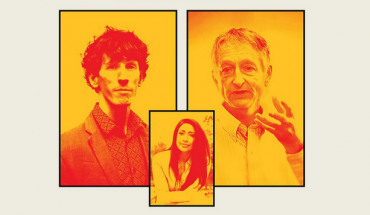It’s the art of the word, writ large across the centuries, accented by modern interpretations and technologies. It’s a showcase of classical and contemporary, combining abstract painting and Arabic calligraphy.
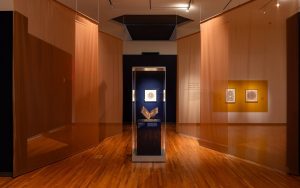
The latest exhibition at the Aga Khan Museum in Toronto, called As the Sun Appears from Beyond: Twenty Years of the Al Burda Award, is making its North American debut. Image by Aly Manji.
It is the latest exhibition at the Aga Khan Museum in Toronto, where As the Sun Appears from Beyond: Twenty Years of the Al Burda Award is now making its North American debut.
Following a successful opening at the Louvre Abu Dhabi in December 2024, the exhibition opened here in June, the result of a unique Memorandum of Understanding between the Aga Khan Museum and the United Arab Emirates Ministry of Culture.
On display are more than 60 amazing contemporary artworks from the Al Burda Award collection, celebrating Islamic art and culture and honouring artistic accomplishments in calligraphy, poetry, and ornamentation. They are placed alongside historical masterpieces from the Aga Khan Museum Collections, so visitors find themselves in a space among written words, physical images, creative ideas and spiritual aspirations past and present.
The art form of calligraphy developed alongside the spread of Islam, with its origins tracing back to the 4th century. Since then, calligraphy has been used to beautify the Quran and spread Islamic teachings throughout the Muslim world. It’s also found its way into modern marketing, branding, and digital design.
From visual art to an interactive audio listening station, the new exhibition shines a light on the art of beautiful writing, and how a simple – or an amazingly ornate and complex – line can connect spirituality and creativity.
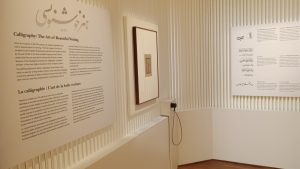
Calligraphy requires not only artistic skill but a kind of meditative attention to detail. Examples, details, and explanations of the art form are on display. Photo by Lee Rickwood.
Calligraphy, often created with a special pen or brush, requires not only artistic skill but a kind of meditative attention to detail. Islamic calligraphy is both a kind of artistic expression and a means of spiritual reflection, connecting one to faith, belief, and beyond.
Calligraphers can combine different sizes, colours, and styles of text for different phrases or sections of a document, but they always stick to certain rules of artistic design and proportionality. Likewise, they can use different pen strokes and angles to create different lettering styles.
As such, Arabic script is as ornamental as it is informative. A single word may look like a collection of random brushstrokes. A single letter can look like a decorative bow of ribbon.
Calligraphic works on paper are often enhanced by decorative frames or backgrounds. Art framing art. And at the Aga Khan Museum, calligraphy can be accented by multimedia.
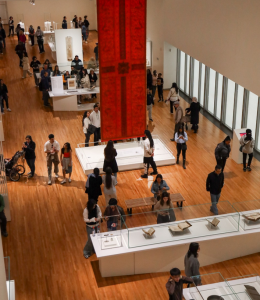
Visitors find themselves in a space among written words, physical images, creative ideas, and spiritual aspirations. Aga Khan Museum Instagram image.
So museum curators and skilled calligraphists must strike a balance between expressing meaning clearly and conveying text beautifully. A canon or code of aesthetic rules has been developed so calligraphic artwork does not distract from the content of the text, and the curatorial team has developed several interpretive panels that provide insight and information about the artworks on display and the artistic disciplines applied when creating them. There are, in fact, six main styles of Arabic calligraphy: Kufic, Naskh, Muhaqqaq, Diwani, Thuluth, and Reqa’, each with unique stylistic elements and applications.
Visitors to the exhibition learn about the tools of the trade, and how the calligraphic technologies have developed over the years.
Special calligraphy pens with flat, round or pointed nibs are of course crucial to the art form. Reed pens, made from tall wetland grasses, are usually trimmed to suit the style of script being created, be it thin or wide. Ink pens, while conveniently available in various sizes (and with built-in ink reservoirs), are easy to use for modern writing but may not equal the precision of reed pens. The calligraphy brush and quill pen are often used as well.
Inks are crucial, too: black is used mostly for precise work with text and adding tonal gradients or subtle shadings; it could be derived from charcoal, soot or lampblack. Coloured inks, often extracted from natural materials like berries, plants, or spices like saffron, are used to accent texts and create artistic embellishments.
The best papers, made from plant or waste fibre, were pulped (soaked or beaten), polished, and then pressed into sheets or volumes, and then highly prized for the ability to absorb ink cleanly and maintain the precise and refined lines of the calligrapher.
The calligrapher would also have other tools at hand, including inkwells (often made from porcelain or glass), pen tip cleaners (to remove excess ink from the pen and prevent – yikes! – drips or smudges), as well as special mounts or holders for the paper itself (polished papers especially can easily slip when writing on them).
As the Sun Appears from Beyond was co-curated by Fatma Mahmoud, Sara bin Safwan, and Shaikha Al Zaabi, in collaboration with the Aga Khan Museum. The young Emirati curators represent the first cohort of Al Burda Fellows, selected by the UAE Ministry of Culture to curate the Al Burda Award’s remarkable 20-year collection.
They all came to Toronto in July 2024 for a professional residency at the Aga Khan Museum before developing the exhibition around the theme of “light”, or Al-Noor, in celebration of 20 years of the Al Burda Award and the Museum’s 10th anniversary.
That Memorandum of Understanding between the Aga Khan Museum and the UAE Ministry of Culture will in part trigger a series of educational and artistic initiatives for young professionals, art practitioners, and students, providing collaborative training, mentorship, and creative development opportunities in the future.
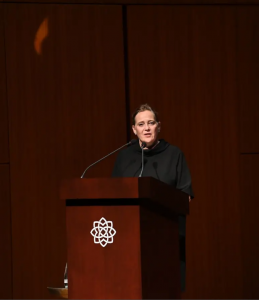
Dr Ulrike Al-Khamis, Director and CEO of the Aga Khan Museum, speaks at the exhibition opening. AKDN / Akber Dewji image.
“The collaboration with the UAE Ministry of Culture and its three exceptional Al Burda Fellows has been an honour and a joy. Working on such a prestigious project together, across and beyond cultural differences, has been a truly enriching and inspiring experience for the Museum,” said Dr. Ulrike Al-Khamis, Director and CEO of the Aga Khan Museum, when describing the project.
“To that end, our storytelling approach is not only factual but also allows for empathetic, inclusive engagement. Striving for the art to be presented in a way that transcends cultural differences, the exhibition invites aesthetic appreciation, engenders conversation, and serves as a creative resource for intercultural learning.”
The exhibition honours and documents the two decades development of the Al Burda Award, a prestigious acknowledgement of artistic achievement in Islamic art and culture.
One section of the exhibition provides an historical perspective using photographs and videos that highlight key milestones of the Award since its launch, along with the artists who contributed to shaping its legacy.
The winning words of poets are showcased in a dedicated Poetry section of the exhibition; poetry is considered one of the finest forms of Islamic artistic expression, and poetry has been one of the main pillars of the award since its launch in 2004. Selected examples of classical Arabic and Nabati poetry address the theme of “light” and celebrate the Prophet Mohamed as a symbol of light and guidance.
The exhibition features display sections where distinctive works focus on certain chapters of the Quran, while others show artistic reflections on the key values of unity, mercy, and spiritual guidance inherent in Islam. There’s a section in which a display of classical Arabic poetry is accented by traditional calligraphy, geometric patterns, and works of modern art.
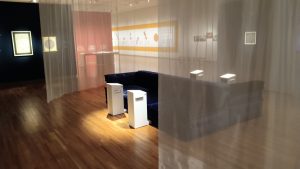
A meditative space in the exhibition includes audio listening stations. Photo by Lee Rickwood.
And there’s a unique section that blends physical, spiritual and virtual interpretations of Islamic art. Designed as a meditative lounge, the work in this multi-media environment features images and audio recordings from devotional performances of the art of religious singing known as Al Malid.
As well as the exhibition itself, several talks, lectures, hands-on workshops, performances and other programming events will help visitors explore the development of Islamic art over the centuries, through calligraphy, ornamentation and contemporary works.
The exhibition runs through Sunday, February 15, 2026.
# # #
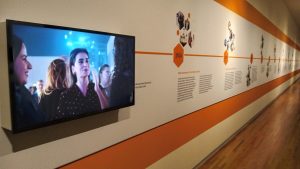
Video clips and a graphic timeline in the exhibition honour and document two decades of the Al Burda Award, a prestigious acknowledgement of artistic achievement in Islamic art and culture. Photo by Lee Rickwood.
more articles on Aga Khan Museum


